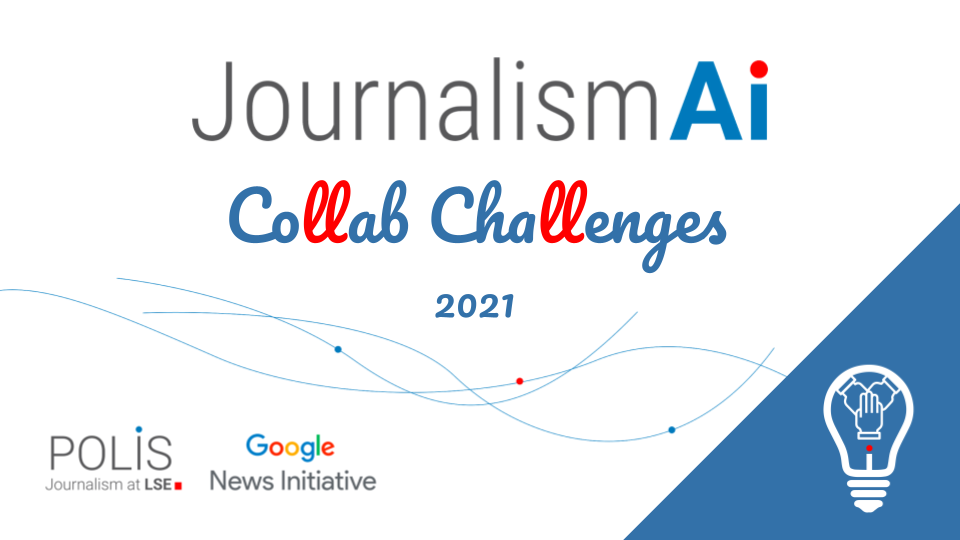“How might we use modular journalism and AI to assemble new storytelling formats?” This is the question that the EMEA cohort of the 2021 JournalismAI Collab Challenges explored over the past six months. In this article, David Caswell (Executive Product Manager at BBC News Labs), who supported the participants throughout the Collab, explains the principles that guided the work of the cohort and presents the final six projects that came out of this initiative.
For many reasons, journalism needs to change. The failing business models and overwhelming competition for attention in the digital era have been pressuring news organisations for almost two decades. More recently, it has become obvious that traditional journalism is not serving most people, communities, and societies in ways that genuinely fit their information needs in the 21st century. More recently still, a new and rapidly growing challenge to traditional journalism has emerged: intelligent systems, synthetic media, and machine learning algorithms that can automate information and communication in much the same way that industrialisation and electricity automated the production of material goods. These factors threaten traditional journalism, but they also offer real opportunities. They invite us to imagine new forms of news that take advantage of artificial intelligence to genuinely serve everybody, while also making journalism relevant and financially sustainable in the hyper-competitive digital media ecosystem.
How might this look in practice? What would be different about an AI-enabled journalism that actually served everybody instead of just news junkies and insiders? And how exactly would it be more sustainable? Answering these questions requires reconsidering the ‘first principles’ of news: the fundamental units or artifacts that journalism produces. The first news articles appeared in 1605, the first radio news broadcasts in 1920, and the first television news broadcasts in 1940 – all mimicking early forms of handwritten or oratory communication. If we really want to fundamentally adapt journalism to a new AI-mediated digital reality, we must ask ourselves if these traditional ‘one-size-fits-all’ units are still appropriate for serving audiences in the 21st century. And if we changed those units of news, if we replaced them with new units – modules of news that were more explicitly intentional, more flexible, and more directly accessible to intelligent tools – then what could we build?
This was the question that the EMEA cohort of the 2021 JournalismAI Collab Challenges explored over the past year: “How might we use modular journalism and AI to assemble new storytelling formats?“. A group of journalists, technologists, and managers from diverse newsrooms across Europe, the Middle East and North Africa – supported by news innovation teams from across the UK – spent six months breaking apart the artifacts of traditional journalism and putting them back together in new ways. Their common objective was centred on combining this different interpretation of news with the tools of AI to find new ways of serving the many audiences and individuals left out of many of the existing experiences of news. Whether opening up financial news to younger audiences, making journalism more accessible to casual news consumers, or enabling easier access to the full breadth of topics and storylines produced across newsrooms, the participants looked at ways of combining modularity and AI to adapt news to news consumers, instead of the other way around.

Every reinvention requires a new foundation – a thoughtful new way of looking at the world at its most fundamental level. Applying AI to modular storytelling is no exception, and in the EMEA Collab this essential challenge was met by teams from Il Sole 24 Ore in Italy, Deutsche Welle in Germany, the Maharat Foundation in Lebanon, and the Clwstwr media innovation initiative in Wales. Together they developed an ‘algebra’ for modular journalism, grounded in academic theory but developed as a pragmatic framework for producing news in ways that can adapt to audiences. This approach was demonstrated in a range of articles published in Italian, Arabic, and English, enabling the challenges faced in producing this kind of journalism within existing newsrooms to be explored.
While modular forms of news can be produced manually, it is the potential of automation to enable modular news production at scale that would open up its widespread use. Participants from the Guardian in the UK and AFP in France addressed that challenge, seeking ways to automate the extraction of one key module from news: the simple quote. Their work explored several approaches, including rules and machine learning, revealing that quotes are more complex than they may appear and that finding models that enable their detection requires human learning as well as machine learning.
Another fundamental module of news is the simple fact. Facts are essential context for most news stories, but the usefulness of their inclusion in news is not simple. Some people want or need careful factual context with every story, perhaps because they are new to a subject. Others expect more evidence to accompany news in the digital media ecosystem, a need that is perhaps less important for those who have grown to trust news providers over many years. These needs were explored by participants from Bayerischer Rundfunk and the Science Media Center in Germany, who explored the use of knowledge graphs to store and organise fact modules supporting climate change stories with added context, and also by a team from Media City Bergen in Norway who tested whether the addition of ‘fact boxes’ to stories can increase their usefulness to young people.
Deconstructing news into modules can be useful in itself, but its usefulness increases when reassembling those modules into new experiences of news that adapt to audiences. Often these experiences will be familiar formats, but they can also be new artifacts that are larger than articles or programmes. One such artifact was explored by a team from Swedish Radio, who used various machine learning tools to deconstruct audio podcasts into smaller units of audio and then re-combine those units into longer audio experiences centred on a particular topic. These ‘Pick-and-Mix’ experiences offer access to the full range of reporting on a chosen topic from across the Swedish Radio content, bringing together elements of a subject that would not be accessible in any other way. A complementary approach to constructing larger news artifacts from smaller units was explored by TX Group in Switzerland. They developed an approach to assembling storylines by selecting articles that represented key points in long-running narratives. This storyline detection approach showed how it may be possible to change how people follow the news, opening up easier access to stories at each person’s convenience instead of expecting daily ‘news junkie’ behaviour.
So what might AI-enabled journalism look like in the 2020s? It might look like stories that are presented and arranged differently for different audiences, acknowledging and serving their different needs in different situations. It might look like stories that provide clear visibility of whose voices are quoted, and whose are not – or perhaps stories that feature different voices that empathise with, or even challenge different audiences. It might look like science journalism stories that adjust their context to the individual readers – less background or factual detail for audiences already familiar with a subject and more for those who are encountering it for the first time. It might be stories that provide ‘fact boxes’ for younger audiences or for those who prefer more evidence in the news they consume. It might sound like a podcast or a news bulletin from a voice agent that gathers the entire breadth of the newsroom’s expertise on a topic into an engaging audio experience, adapted to the listeners and their interests. Or it might look like an adaptable storyline that enables audiences to understand and engage with continuing stories in their own time and at their own pace, opening up news to those who can’t or don’t want to follow every story every day. It might also look like a combination of all of these and other approaches: adjusting news experiences to each individual’s needs and preferences.
Artificial intelligence will likely continue to change news in many ways in the coming years, but these projects have clearly demonstrated one major opportunity presented to journalism by AI: the possibility of making news more adaptable, more accessible, and more available to more people. But modular, AI-enabled journalism might also offer something more for news organisations themselves: a way to reduce their dependence on platforms for traffic and an opportunity to rebuild direct relationships with audiences. This opportunity arises from the fact that an adaptable experience, assembled from modules and personalised to the audience member, cannot be indexed and ranked in the same way that articles, videos and audio files can. Instead, the value to audiences from adaptable news is most apparent on the news organisations’ app or website, backed by catalogues of modular units of news and the AI-enabled systems that assemble them into valuable experiences. We are still years away from this kind of digital news environment, adaptable to audiences and sustainable for news organisations, but the new tools of AI combined with new interpretations of news can enable real progress. The participants of the 2021 EMEA Collab Challenges have together shown us how that can be done.
Explore all the projects of the 2021 JournalismAI Collab Challenges on the website and sign up for the JournalismAI newsletter to stay up-to-date about our activities in 2022.
JournalismAI is a project of Polis, supported by the Google News Initiative.







